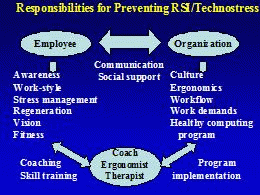From technostress to technohealth: A training protocol
After implementing a six-session training intervention at the worksite which incorporated biofeedback, Peper et al (2004) demonstrated that employees report significant improvement in their health. The detailed training protocol and methodology has been described in the book, Muscle Biofeedback at the Computer, by Peper and Gibney, 2006. This technohealth intervention is rooted in a systems perspective, where preventing technostress and the specific symptoms associated with repetitive strain injury (RSI) results from a collaboration between the employee, managers and the corporation. The many components that contribute to shifting technostress to technohealth are illustrated in Figure 3.
Figure 3. The multiple factors that contribute to the prevention of repetitive strain injury and technostress. The responsibilities are shared with both the employee and the employer.
The technohealth training intervention consisted of six weekly, two-hour group sessions consisting of an educational component as well as practice of muscle tension awareness and control as measured by surface electromyography (SEMG) (see Table 1 for detailed outline of group training sessions). The practice component included using SEMG measurements for demonstrating increased tension during data entry and, for practicing slow diaphragmatic breathing during computer work. Additionally, participants learned how to use SEMG feedback of muscle tension during on-going activities at their workstations. Participants practiced both at home and at the worksite with portable SEMG equipment, focusing on: 1) raising awareness of shoulder tension while typing or mousing; 2) improving the ability to relax forearms by increasing the duration of micro-breaks; and, 3) noticing the effect of various body positions and ergonomic postures on subsequent SEMG activity (Peper & Gibney, 2000).
The educational component was labeled Healthy Computing and provided a general overview of technohealth concepts that included: somatic awareness, stress management, psycho-social support, ergonomic principles, work style, vision care, regeneration, and strength and flexibility training. In addition, the intervention provided group support as well as supervision in learning to apply these skills personally or with others.
Participants in the technohealth intervention were responsible for keeping logs of shorter or longer duration breaks while working at the computer, which they identified as micro-, meso-, and macro-breaks. An example of a micro-break was dropping one's hands on the lap and reducing forearm muscle tension for one or two seconds. An example of a meso-break was stopping to stretch the arms or even the total body for five to 20 seconds. A macro-break was taking time out to move the whole body such as going for a walk for several minutes. Trainees were also encouraged to augment their awareness by installing on their computer an "interrupt program' designed for alerting the users to take breaks at set intervals. Finally, each participant was asked to transfer what they had
learned to other by coaching other co-workers on the best methods for utilizing the knowledge and skills gained from the program as well as using the portable SEMG biofeedback equipment for directly monitoring excessive muscle tension while computing. All participants verbally reported during the group training sessions that they had increased the frequency of taking breaks, practicing with SEMG biofeedback equipment and, teaching others what they had learned.
At the conclusion of the study, the Technohealth Experimental and Control Group subjects were each mailed or emailed post-intervention rating forms. The forms included a work-related symptom and work style questionnaire in which they rated their self-report changes as compared to the beginning of the training. Completed post-intervention forms provided the data for comparing intervention effectiveness. For example, employees from departments without co-workers who participated in the program had increased numbers of worker's compensation injury claims. More evidence of the technohealth intervention impact is presented in greater detail in the results section below.
Table 1: Syllabus of Six Week Coaches Training Program




